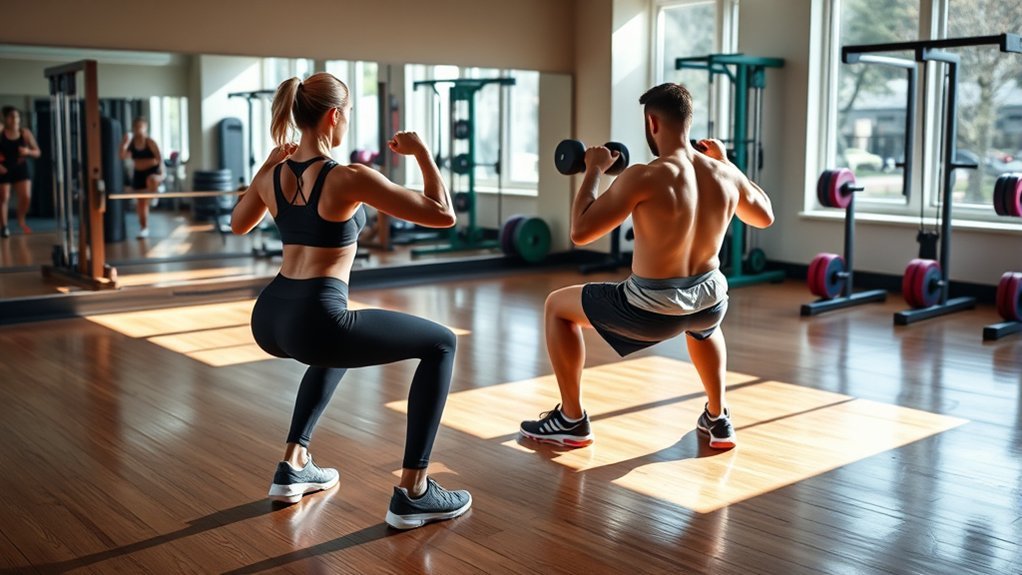When it comes to exercise, knowing the do’s and don’ts can make a big difference in your performance and safety. It’s essential to warm up and cool down properly, and to pay attention to your body’s signals. You’ll want to maintain good form and stay hydrated throughout your workouts. But what happens when you start to feel fatigue or pain? Understanding these aspects is vital, and there’s more to take into account for a well-rounded approach.
The Importance of Warming Up

Warming up is essential before any workout, as it prepares your body for physical activity and reduces the risk of injury.
When you warm up, you increase blood flow to your muscles, making them more flexible and ready to perform. Start with light cardio, like jogging or jumping jacks, for about five to ten minutes.
Then, incorporate dynamic stretches that engage the major muscle groups you’ll be using. This not only enhances your performance but also helps you mentally prepare for the workout ahead.
Remember, a good warm-up can make a significant difference in how you feel during exercise.
Mastering Proper Form

Mastering proper form is essential for maximizing your workouts and preventing injuries.
You’ll want to focus on your alignment, learn effective breathing techniques, and recognize common mistakes that can derail your progress.
Let’s break down these key elements so you can exercise safely and effectively.
Importance of Alignment
While some might overlook the importance of alignment in exercise, mastering proper form is essential for achieving your fitness goals and preventing injuries.
When you focus on alignment, you enhance your performance and protect your body. Here are some key aspects to keep in mind:
- Maintain a straight spine to support your back during lifts.
- Align your knees over your ankles to reduce joint strain during squats.
- Engage your core to stabilize your body and improve balance.
- Keep your shoulders relaxed and down to avoid tension and promote fluid movement.
Breathing Techniques Explained
Proper alignment sets the stage for effective breathing techniques, which play a significant role in enhancing your workout performance. When you breathe correctly, you maximize oxygen intake and improve endurance. Practice diaphragmatic breathing: inhale deeply through your nose, allowing your belly to expand, and exhale slowly through your mouth. This method helps stabilize your core and maintain focus.
| Breathing Technique | Benefits | When to Use |
|---|---|---|
| Diaphragmatic Breathing | Increases oxygen flow | During strength training |
| Controlled Exhales | Reduces fatigue | During cardio sessions |
| Rhythmic Breathing | Enhances rhythm | Throughout workouts |
| 4-7-8 Breathing | Promotes relaxation | Pre-workout |
| Box Breathing | Improves focus | During high-intensity |
Focus on mastering these techniques to elevate your performance!
Common Form Mistakes
Many people overlook the importance of maintaining proper form during workouts, which can lead to injuries and hinder progress.
To guarantee you’re getting the most out of your exercises, watch out for these common form mistakes:
- Rounding your back during lifts, putting unnecessary strain on your spine.
- Locking your knees while standing, which can cause joint pain and instability.
- Shrugging your shoulders during upper body exercises, limiting range of motion and strength.
- Looking down instead of forward, affecting balance and alignment.
Listening to Your Body

How can you tell when your body needs a break or when it’s ready to push harder? Pay attention to signals like fatigue, soreness, and mood.
If you feel unusually tired or experience sharp pain, it’s a sign to rest. On the flip side, if you’re energized and your body feels strong, you might be ready to increase your intensity.
Remember, listening to your body isn’t just about physical sensations; it also involves your mental state. If you feel motivated and focused, that’s a great cue to challenge yourself.
Trust your instincts—your body knows best. By tuning in, you’ll not only prevent injuries but also enhance your overall performance and enjoyment of exercise.
Keep moving, but always respect your limits!
Incorporating Variety in Workouts
Incorporating variety in your workouts not only keeps things fresh but also helps you avoid plateaus and burnout.
When you mix things up, you challenge your body in new ways, leading to better results and sustained motivation.
Here are a few ideas to spice up your routine:
- Try a new fitness class: Explore yoga, kickboxing, or dance for a fun change.
- Change your workout environment: Head outdoors for a run or find a new gym.
- Switch up your equipment: Use resistance bands, kettlebells, or stability balls for different challenges.
- Alter your workout schedule: Experiment with morning sessions instead of evenings or vice versa.
Keep your workouts exciting and enjoyable, and you’ll be more likely to stick with them long-term!
Staying Hydrated
Staying hydrated is essential for your overall performance and well-being during workouts.
When you’re active, your body loses water, and recognizing the signs of dehydration can help you maintain your energy levels.
Let’s explore why hydration matters and how to guarantee you’re drinking enough to support your fitness goals.
Importance of Hydration
While you might focus on your workout routine, don’t overlook the essential role of hydration in your fitness journey. Staying hydrated keeps your body functioning at its best.
When you drink enough water, you’ll experience:
- Increased energy levels, making workouts feel easier
- Improved concentration, helping you stay focused on your goals
- Enhanced recovery, allowing your muscles to repair faster
- Better temperature regulation, keeping you cool during intense sessions
Make it a habit to drink water before, during, and after your workouts. You can also include hydrating foods like fruits and vegetables in your diet.
Signs of Dehydration
How can you tell if you’re not drinking enough water? Pay attention to your body. Signs of dehydration include dry mouth, fatigue, and dark yellow urine. If you feel unusually thirsty, that’s your body’s way of signaling it needs more fluids.
You might also experience headaches, dizziness, or trouble concentrating. During exercise, inadequate hydration can lead to muscle cramps and reduced performance.
Make it a habit to drink water throughout the day, especially before, during, and after workouts. If you notice any of these symptoms, don’t ignore them—take a break, sip some water, and allow your body to recover.
Staying hydrated is essential for peak performance and overall health, so prioritize it in your daily routine!
Setting Realistic Goals
Setting realistic goals is essential for anyone looking to improve their fitness journey. When you set achievable targets, you’ll stay motivated and see progress.
Here are some tips to help you create effective goals:
- Focus on specific outcomes: Instead of saying, “I want to get fit,” aim for “I’ll run 3 miles without stopping.”
- Set a timeline: Give yourself a deadline, like “I’ll lose 5 pounds in two months.”
- Break it down: Divide larger goals into smaller milestones to track progress easily.
- Celebrate achievements: Reward yourself for reaching each milestone, no matter how small.
Avoiding Overtraining
As you work toward your fitness goals, it’s important to recognize the signs of overtraining. When you push yourself too hard without adequate rest, you risk fatigue, decreased performance, and even injury.
Keep an eye out for symptoms like persistent soreness, irritability, and trouble sleeping. To avoid overtraining, listen to your body and incorporate rest days into your routine.
Be mindful of signs like soreness and irritability; prioritize rest days to prevent overtraining and support your fitness journey.
Mix up your workouts to include different types of exercises, which can help prevent burnout. Remember, recovery is just as significant as the workouts themselves.
Make sure you’re fueling your body with proper nutrition and hydration. By respecting your limits and allowing time for recovery, you’ll stay motivated and achieve your fitness goals more effectively.
Cooling Down and Stretching
While you might feel enthusiastic to finish your workout and move on with your day, taking the time to cool down and stretch is essential for your recovery.
Cooling down helps your heart rate return to normal and prevents dizziness. Stretching improves flexibility and reduces muscle soreness.
Here are some key points to include in your routine:
- Gentle walking for 5-10 minutes to lower your heart rate gradually.
- Static stretches targeting major muscle groups, holding each for 20-30 seconds.
- Breathing exercises to promote relaxation and oxygenate your muscles.
- Hydration to replenish fluids lost during your workout.
Incorporate these practices consistently, and you’ll feel better prepared for your next session!
Seeking Professional Guidance
How can you guarantee your exercise routine is both safe and effective? Seeking professional guidance is a great first step. A certified personal trainer can tailor a program specifically for you, considering your fitness level, goals, and any health concerns.
They’ll teach you proper techniques to prevent injuries and ascertain you’re getting the most out of each exercise.
Additionally, consulting with a physician or a physical therapist can provide insights, especially if you have pre-existing conditions.
Remember, professional advice isn’t just for beginners; even seasoned athletes benefit from expert input. So, don’t hesitate to ask for help.
Investing in your fitness journey with professional guidance can lead to greater success and long-term health benefits.
Frequently Asked Questions
How Do I Choose the Right Workout Gear?
Choose workout gear that fits well, supports your activities, and keeps you comfortable. Look for breathable fabrics and the right footwear. Don’t forget to take into account your personal style; feeling good boosts motivation!
Can I Exercise on an Empty Stomach?
Exercising on an empty stomach is like sailing without wind; you might struggle. While some thrive, others feel weak. Listen to your body—if you’re energized, go for it; if not, fuel up first!
What Are the Best Recovery Foods Post-Workout?
After your workout, focus on protein-rich foods like chicken, fish, or legumes, along with carbohydrates like quinoa or sweet potatoes. Don’t forget hydration; water or a recovery smoothie can help replenish your energy effectively.
How Often Should I Change My Workout Routine?
You should change your workout routine every 4 to 6 weeks. This keeps your body challenged, prevents plateaus, and maintains your motivation. Listen to your body, and adjust as needed to continue progressing.
What Are the Signs of a Workout Plateau?
You’ll notice signs of a workout plateau when your progress stalls, you feel fatigued, or your motivation dips. If you’re not seeing results, it’s time to reassess and refresh your routine. Keep pushing forward!
Conclusion
Incorporating these exercise guidelines into your routine can make all the difference in achieving your fitness goals safely. Did you know that nearly 80% of people experience injuries due to improper form or overtraining? By prioritizing warm-ups, staying hydrated, and listening to your body, you can greatly reduce your risk of injury and enhance your performance. Remember, it’s not just about working hard; it’s about working smart. Keep pushing forward, and you’ll see the results you’re aiming for!
